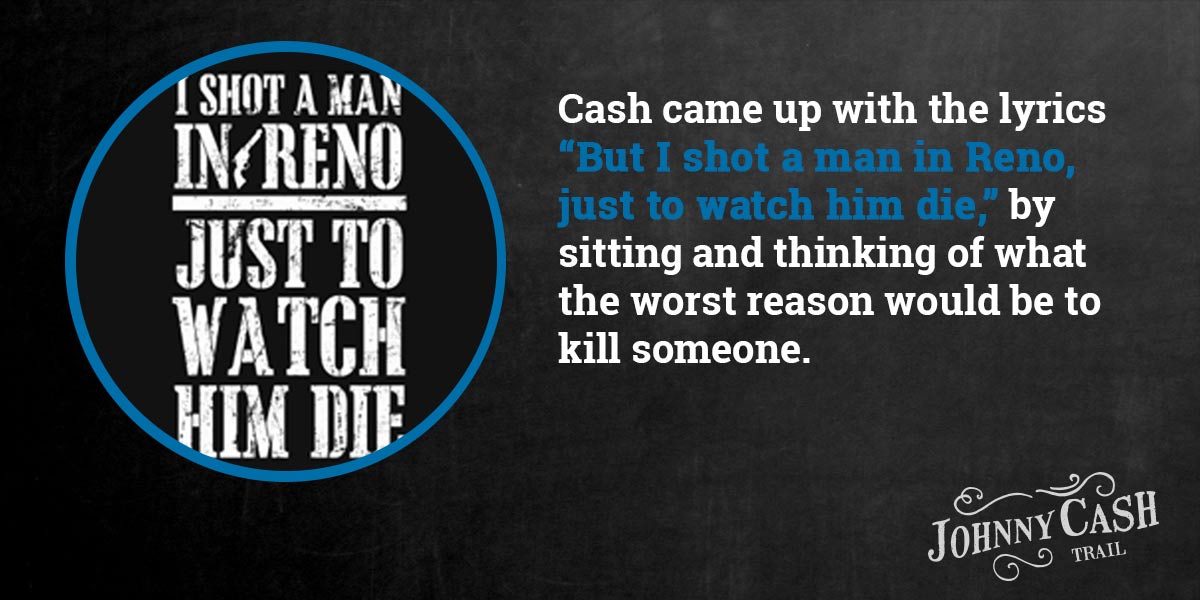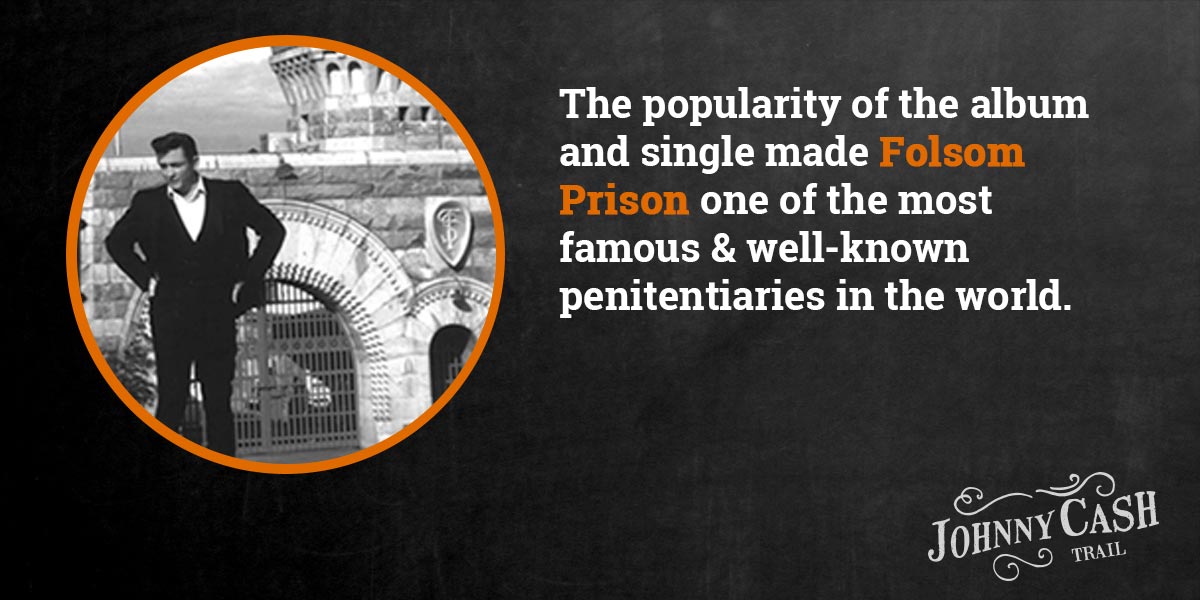On January 13, 1968, Johnny Cash performed live in front of an audience of guards and inmates at Folsom Prison. Four months later, Folsom Prison Blues hit the Billboard Top 100 chart. Having a single on a Billboard chart was nothing new for Johnny Cash, but this particular song represented a turning point in the legendary musician’s career and made an indelible mark on the history of Folsom.
The anthem would become one of Cash’s most beloved and well-known songs, one that continues to inspire musicians today. And Folsom Prison would forever be associated with Cash’s Folsom Prison Blues.
The REAL Story behind Folsom Prison Blues
To commemorate the 50th anniversary of Cash’s iconic album and single, we’re taking you behind the scenes and uncovering the facts that even the most hard-core Johnny Cash fans may not know about this legendary song, the album, and the Man in Black himself.
Cash Wrote Folsom Prison Blues in the Air Force
Before he became a country music legend, Cash enlisted as a member of the United States Air Force in 1950.
After completing basic training, Cash was assigned as a morse intercept officer and stationed in Landsberg, Germany in 1951.
“The Air Force taught me the things every military service imparts to its enlisted men … plus one skill that’s pretty unusual: if you ever need to know what one Russian is signaling to another in Morse code, I’m your man.”
Cash: The Autobiography, by Johnny Cash and Patrick Carr
During his time as a morse interceptor, despite his military success (Cash was the first to intercept news of Stalin’s death), music remained on Cash’s mind.
Johnny Cash had been playing the guitar and writing songs since he was 12 years old. His mother once scraped together enough money for singing lessons, but his teacher was so impressed with young Cash’s natural talent that she sent him home with a warning never to change his voice.
While enlisted in Germany, Cash used his first steady paycheck to buy his first guitar (it cost him $5 US dollars), and later, a tape recorder. Cash worked on his singing and even listened to the Grand Ole Opry live from Tennessee on the military radio equipment.
In 1953, Cash saw Crane Wilbur’s film Inside the Walls of Folsom Prison while stationed in Germany. The 90-minute long film left an impression on Cash, who emphathized with the tale of the imprisoned men, and inspired him to write a song:
Folsom Prison Blues.
“It was a violent movie,” remembers Cash. “And I just wanted to write a song that would tell what I thought it would be like in prison.”
Johnny Cash at Folsom Prison: The Making of a Masterpiece, by Michael Streissguth
But a prison movie wasn’t the only muse that lead to the creation of this iconic tune; Cash had some lyrical inspiration, as well.
Did you know? While serving in the Air Force and stationed in Germany, Cash wrote a number songs that he would later record professionally:
- Folsom Prison Blues
- Hey Porter
- Run Softly Blue River
- Oh What a Dream
A Tale of Two Cities
Cash adapted both melody and lyrics for Folsom Prison Blues by a song called Crescent City Blues, from a then-uncredited Gordon Jenkins.
Crescent City Blues was written by Jenkins and performed by his wife, Beverly Mahr, on the 1953 album Seven Dreams.
Cash’s lyrics were similar enough to Jenkins’ that he would later settle with the man in court. But at the time, young John R. Cash (as he was called in the Air Force) wasn’t a professional musician with copyright issues on his mind…
He was a young man inspired.
Crescent City Blues vs Folsom Prison Blues
Jenkins’ Crescent City Blues is a slow moving, orchestral love song about a woman dreaming of leaving her Midwestern town.
If I owned that lonesome whistle
If that railroad train were mine
I bet I’d find a man
A little further down the line
In contrast, Cash’s Folsom Prison Blues picks up the tempo for his guitar-centered song about a lonely prisoner longing for his freedom.
Well if they freed me from this prison
If that railroad train was mine
Bet I’d move it on a little
Farther down the line
But I Shot a Man in Reno
One of the most well-known lyrics from Folsom Prison Blues is definitely an original - straight from the imagination of the Man in Black himself.

Cash came up with the lyrics “But I shot a man in Reno, just to watch him die,” by sitting and thinking of what the worst reason would be to kill someone.
Did you know? If you shot a man in Reno in the 1950s, you most likely would have ended up in Nevada State Prison, located in Carson City, NV, and not Folsom Prison. Nevada State Prison opened in 1862 and closed its doors in 2012.
Cash’s Career Takes Off
While in Basic Training, Cash met his first wife, Vivian Liberto. The couple was married in 1954 after Cash was discharged from the Air Force, settled in Memphis, and had four children together.
After Cash left the Air Force, he entered radio school with his GI Bill, hoping to become a disc jockey. But Cash needed a job and, after inquiring about police work, went to work selling appliances, instead.
Cash’s older brother, Roy, had introduced him to two mechanics who liked to strum their guitars together: Luther Perkins and Marshall Grant.
In 1955, Johnny Cash, Luther Perkins, and Marshall Grant signed with a local producer, Sam Phillips of Sun Records. Phillips billed his new artists as “Johnny Cash and the Tennessee Two.”
Cash’s song Folsom Prison Blues was released as Cash’s second single and reached the #4 spot on the Billboard Country Western Best Sellers chart.
Cash’s career began to take off, but the price of fame was steep for the musician. His hard-partying lifestyle took a toll on his family, and drug- and alcohol-use played a role in his divorce from Vivian in 1966.
The next year brought new beginnings and redemption for Cash, starting with his marriage to June Carter: singer-songwriter and member of country music’s founding family. Cash slowly began to overcome his addictions and demons.


13 Fascinating Facts, Stories, and Tales about Folsom Prison
Come explore the lore and legend of Folsom Prison, America’s most famous institution and one of California’s first.
READ MORE

Johnny Cash’s Prison Performances
Cash’s first prison performance occurred in 1957 when he performed for inmates at Huntsville State Prison. The favorable response inspires the country legend to perform at more prisons through the years.
By the late 60’s, Cash’s personal life was on the upswing, but his career was beginning to stall. He pitched the idea for a live album recording at a prison to the new head of Columbia Records, was met with enthusiasm.
On January 10th, 1968, Johnny Cash and June Carter Cash checked into the El Rancho Motel in Sacramento, California. Later, they were joined by the rest of Cash’s band, now the Tennessee Three, as well as performers Carl Perkins and the Statler Brothers.
The performers rehearsed for two days. On the second day, California governor Ronald Reagan had an in-person meeting with the performers, wishing them luck.
There were two performances scheduled to take place at Folsom Prison on January 13th, 1968. The second performance was a safety net in case the first recorded performance didn’t go well.
After Carl Perkins and the Statler Brothers performed, Johnny Cash took the stage. The inmates were silent until they heard the Man in Black introduce himself:
“Hello. I’m Johnny Cash.”
Cash opened both shows with Folsom Prison Blues.
The inmates were quiet throughout the song’s performance, careful not to applaud or cheer at any comments about the prison itself for fear of retaliation from the guards. The cheers heard on the album following the line “I shot a man in Reno, just to watch him die,” were added in post-production.
All but two songs on the album, At Folsom Prison, came from the first performance of the day.

Folsom Prison Blues Climbs the Charts Amid Controversy
It took four months for Columbia Records to release Cash’s album At Folsom Prison. On May 25, 1968, Folsom Prison Blues hit the Billboard Top 100 chart.
The significance of Folsom Prison Blues hitting the Billboard chart is better understood when you consider some of the other artists on the chart that same day. In a sea of artists such as Stevie Wonder, James Brown, Aretha Franklin, Tom Jones, Otis Redding, and the Temptations, Cash’s country sound stood apart from the crowd of Motown and R&B performers.
Folsom Prison Blues came with its fair share of controversy.
The song was pulled from radio stations following the June 5th assassination of Senator Robert Kennedy. The lyrics, “But I shot a man in Reno, just to watch him die,” were considered too offensive after the senator’s shooting death.
Columbia Records quickly edited and re-released the single without the controversial line, despite protests from Cash. The newly edited single was given airtime on radio stations, and welcomed by the public.
Folsom Prison Blues made it to the #1 spot on the Country Western charts and rose as high as the #32 spot on the Billboard Top 100.
Cash Fights for Prison Reform
The success of the album breathed new life into Cash’s career and awakened a new passion in the Man in Black. He began to campaign for prison reform, believing in the powers of redemption and rehabilitation for the inmates he had met over the years.
Cash’s mission to help inmates return to society came from his own past brushes with the law, story of redemption, and self identification as an outsider.
Lasting Success for Folsom Prison Blues
At Folsom Prison stayed on the country music charts for 90 weeks, and in the Billboard Top 200 for 122 weeks. The album was certified Gold in the fall of 1968, and certified Triple Platinum in 2003.
Cash received Grammys for both At Folsom Prison (Best Album Notes, 1969) and Folsom Prison Blues (Best Country Vocal Performance, Male, 1969).
At Folsom Prison and Folsom Prison Blues became a part of the history of the City of Folsom, as well. The popularity of the album and single made Folsom Prison one of the most famous and well-known penitentiaries in the world. For the rest of his life and beyond, the City of Folsom became known for its connection with Johnny Cash.
“I think prison songs are popular because most of us are living in one kind of little prison or another, and whether we know it or not the words of a song about someone who is actually in a prison speak for a lot of us who might appear not to be, but really are.”
– Johnny Cash
